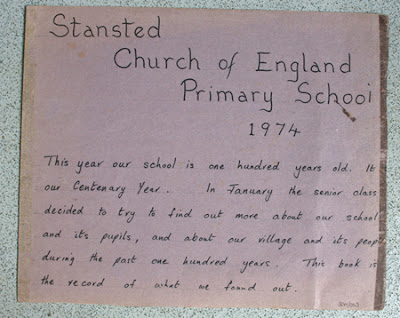I don't know when this booklet was produced, but it was when the rector still lived in Fairseat, at the well known landmark white shiplap clad house which is now known as The Old Rectory. I am guessing that house became a private dwelling some time in the early 80s, when the church sold off a lot of its rather valuable property and bought cheaper housing. The picture shows the house before the right hand side was extended upwards, which I can remember happening in approximately 2003. You can also just see the the rather lovely, large Cedar tree which used to be in the garden. It was in the conservation area so in Dec 2007 permission had to be granted for the tree to be trimmed back. Then I think high winds caused part of it to come down. There is an item in the Parish Council report of April 2009 stating: Mrs Rodway has commissioned a report on the condition of the Cedar in their front garden...the conclusions recommend that the tree should be felled withing three months. (There is no form of tree surgery that would allow the tree to remain in any reasonable form).
Personally, I am very sad when the old trees come down in the area, and I was very upset when winds blew down some fantastic beeches along the part of Fairseat Lane which goes down to the A227. Driving along that road was like driving through a wooded tunnel, with dappled sunlight shining through the leaves. It is still not bad, and give it another couple of hundred years it will be back to its former glory. I once found a big adder along that road, but that is another story, so for now, here below is the promised copy.
'Early documentary records relating to the parish are noted by Hasted and date from 1210. However it is likely that the area was populated well before that date; indeed the parish church of St Mary the Virgin, in Stansted, although itself of uncertain age has a yew tree near the North entrance which is reputed to be at least a thousand years old. Since it was once customary to plant a yew to the North side of a church, it seems likely that a church has existed on this site for a similar period.
The present church probably dates from the 14th century and certainly before 1312. It was restored in 1863.
In the 14th century it seems that the parish was a place of some importance as the residents had the right to hold a three day fair here.
The roads and paths of the parish are likely to have developed through usage over time. Wises Lane was at one time an important road from Dartford to Wrotham and was called Wrotham Road. The present name derives from Wyse's Farm which no longer exists.
An ancient drove road passed through both villages, and parts of this can still be followed. Outside the parish, at the bottom of Vigo Hill on the outskirts of Trottiscliffe, and by the Pilgrims Way stands Pilgrim House which was once an inn called the Kentish Drover. At the top of Vigo Hill stands the Vigo Inn, built around 1471 and then named the Drovers Rest. On the opposite corner there was once a toll house and toll gate on the Gravesend Road.
Proceeding through Fairseat and Stansted, it is presumed that the herds were watered at the various ponds on this route, one of which was at the foot of Stansted Hill, where now stands Stansted's distinctive war memorial statue.
The oldest house in the parish is said to be Church Cottage in Stansted, which is probably late 13th or early 14th century, it would have been used by the priest visiting from Wrotham, to which Stansted was then a subordinate parish.
In Fairseat the house known as Soranks Manor stands on the foundations of a much earlier, medieval manor house. The manor land was held during the reign of Henry III by Ralph de Sandwich. It was passed to Edmund Sorank whose name is recorded in the assize roll of 1313 as a juror for Stansted. Around 1700 the land was bought by one John Cox who built a facade onto the house opposite Fairseat pond and called the house 'Fairseat'. This seems to be the first time in history that the name Fairseat appears, the area having previously been known as Farsee.
Nearby, the Chapel of Holy Innocents, designed by the architect Waterhouse, was built in 1930 by the Waterlow family.
The Old Rectory in Stansted was built in 1847 and housed rectors until 1969 when it was sold and became a private house. Nearby, in the rectory meadow, to the right of the drive entrance in Plaxdale Green Road stood the brick and timber framed Tithe Barn until its demolition in 1920. The present rectory is in Fairseat and is illustrated in the pages of this booklet.
The Vigo Inn has already been mentioned in the context of the ancient drove road. Its present name was given by its owner in the early 18th century who fought under Admiral Rooke at Vigo Bay (Spain) in 1702. The other inns in the parish are: the Anchor and Hope at the northern end of Wises Lane, built around 1537; the Horse and Groom on the A20 near the end of Plaxdale Green Road built in 1770/5; and the Black Horse in Tumblefield Road, which in the 18th century was a dwelling named 'Palmers' until it was licensed by its owner, one Joseph Fremlln, between 1833 and 1847, whereupon its name was changed to the Black Horse.'
 |
| The Old Rectory, Fairseat, when it was still The Rectory! |
 |
| Church Cottage, Stansted, reputedly the oldest in the parish |






















































